Net Promoter Score: The Definitive Guide to NPS

If I told you you could unlock outstanding customer service, increase customer loyalty, and even boost revenue with one simple question, would you believe me?
Welcome to the world of Net Promoter Score (NPS).
You have seen those one-question surveys pop up when you’re browsing a website or in your emails.
It asks how likely you are to recommend a company, product or service, and provide a scale of 0-10 for your response.
You may even already use these to get a gauge of how much your customers like what you’re offering.
But NPS is so much more than just a simple question.
It measures customer experience, and can also put you on the path to business growth by identifying pain points in your customer experience, what your customers love about you, and referral and upsell opportunities.
We’ll be taking you through everything you need to know about Net Promoter Score.
Let’s get started.
What is a Net Promoter Score?
Net Promoter Score (NPS) is a closed-loop feedback system used to provide insights into key areas of customer loyalty such as:
- Customer satisfaction
- Retention
- Engagement
- Business growth
Developed by Fred Reichheld of Bain & Company, in collaboration with Satmetrix Systems, NPS was quickly touted as ‘The One Number You Need to Grow’, after its introduction in 2003.
This new metric said goodbye to lengthy customer satisfaction surveys and focusing on one key loyalty-based question:
“How likely are you to recommend us to a friend or colleague?”
Why does NPS matter today?
Two decades on from its introduction and Net Promoter Score (NPS) survey is still one of the most important ways to measure loyalty.
We’ve outlined 4 reasons why NPS is still a core measurement of customer experience:
- Gauge customer loaylty
- Faster insights
- Turn responses to revenue
- Common goal for business growth
1. Gauge customer loyalty
The higher the score, the happier your customers are.
NPS Promoters, those enthusiastic customers who will recommend your business to their friend or colleague, indicate how loyal customers are at that moment in time.
“We will focus our organization on what we call Net Promoter score, which goes much beyond the pure customer satisfaction index,” said René Obermann, former CEO of T-Mobile International.
What’s more, the simplicity of the survey allows you to run the research on a regular basis so that you can benchmark loyalty and start tracking the trends.
2. Faster insights
As a single-question survey, it’s more likely to get a higher response rate than the longer surveys. It can also be analyzed and reported on faster, delivering insights to those who need them.
Trustmary's NPS surveys' completion rate normally is the same as the open rate. In other words, NPS survey is so easy to answer that practically no-one leaves it unfinished once they open it.
“Too many of today’s satisfaction survey processes yield complex information that’s months out of date by the time it reaches frontline managers.” Fred Reichheld, Bain & Company.
3. Turn responses to revenue
NPS survey responses can pinpoint when and where in the customer journey loyalty is at its highest, identify those buyers who are prime for upselling or repeat purchases, and even help predict customer churn.
In fact, research from Temkin showed that Promoters are 4.2 times more likely to buy again, 5.6 times more likely to forgive a company after a mistake and 7.2 times more likely to try a new offering compared with the Detractors.
Former CEO of Intuit, Steve Bennett, once said, “So what’s driving growth?… [W]e measure the customer experience using a system called Net Promoter. The higher the score, the more customers are delighted with the product and service experience and would recommend it to a friend.”
4. Common goal for business growth
It’s simplicity also means it can be used in different parts of your customer journey. In fact, Jason Lemkin, SaaStr, explains how NPS can help to encourage cross-functional working by giving every team the same goal to work towards:
“It’s the voice of the customer. If you have a high NPS score, you’re doing something right here, no matter the feature gaps or other issues. If it’s low - take action, my friends.”
5. Benchmarking and competitive advantage
NPS provides a benchmark against industry peers, offering valuable context on where your company stands in the market. In 2025, as businesses vie for customer loyalty in a saturated market, understanding your NPS in relation to competitors can highlight areas for improvement and help differentiate your brand.
How Do I Measure My Net Promoter Score?
Calculating Net Promoter Score starts with the aforementioned question: "How likely are you to recommend X to your friends or colleagues?"
Rated on a scale of 1 to 10 (with 10 being most likely), the responses provided can be sorted into three main categories: Promoters, Passives, Detractors.
The more customers that rank your company as 9 or 10, the better your customer experience is.
The NPS calculation formula works by subtracting the percentage of Detractors from the percentage of Promoters. This will give you a score between -100 (no Promoters) and +100 (no Detractors).
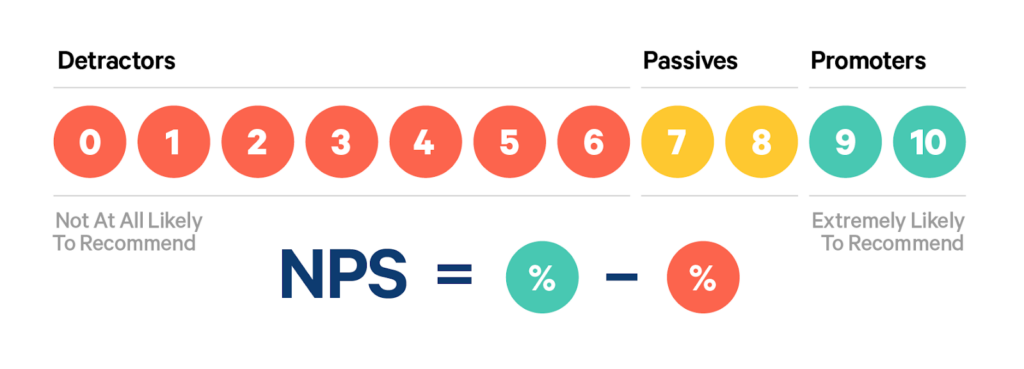
Let's take a closer look at what the individual numbers say about respondents.
- Score 9 or 10 – Promoters: These are loyal enthusiasts and will help drive business growth. The more promoters you have, the better customer experience you’re providing.
- Score 7 or 8 – Passives: These customers are neutral - they like what you offer but aren’t necessarily loyal to your business.
- Score below 7 – Detractors: These are your most unenthusiastic customers. They are more likely to share negative word of mouth.
Later in the article, we explain more thoroughly what to do about each group.
Example Case of Net Promoter Score in Action
For example, Alpha Inc has 42% Promoters, 39% Passives, 19% Detractors, creating a score of +23.
This a great score for Alpha Inc showing that those buyers who are loyal outnumber those who are not.
But fast forward a few months and a few key business changes and Alpha’s Promoters drop to 32%, Passives increase to 42% and Detractors increase to 26%.
While on the surface these may not seem like huge percentage leaps, the resulting NPS score drops to +6 - a sure sign that change is needed.
Interestingly though, there are two ways to improve NPS:
- Taking steps to turn the unhappy customers into happy ones. According to research, Passives are the easiest to turn into Promoters.
- Or working on their customer experience to address those who are passive in order to build loyalty.
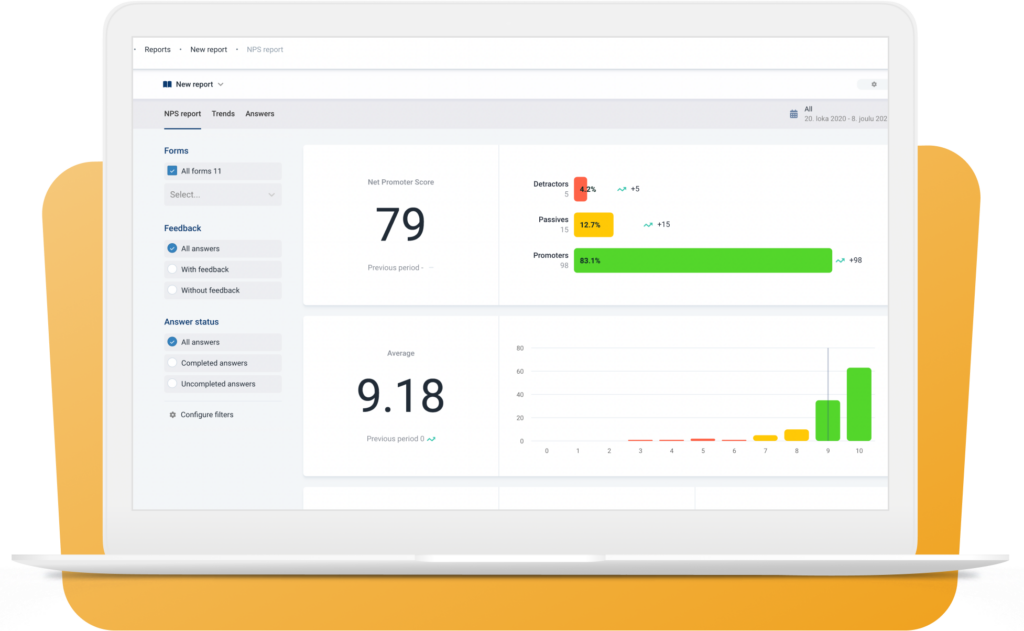
Dig deeper with additional questions
NPS tells you what your customers feel about your business.
Adding a qualitative open-ended question alongside the Net Promoter Score question allows you to dig into why people feel a certain way.
Traditionally, the open-ended questions would have asked why a particular score was given.
See how customers are asked to explain their scores in the example below.
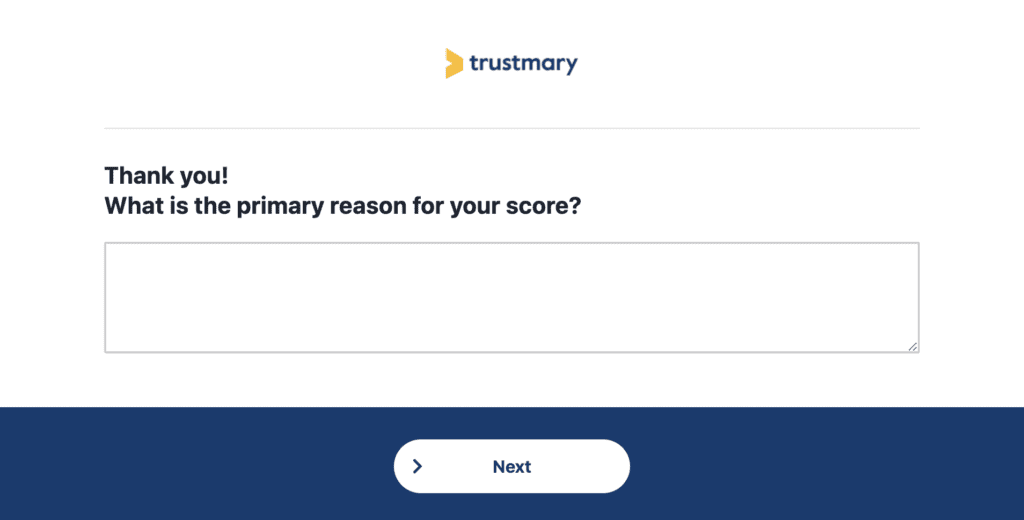
Increasingly, companies are using personalized follow-up questions in response to a particular score given.
The table below shows the different types of questions asked of different respondents.
| Promoter (9 or 10) | What did you love about your experience with us? |
| Passive (7 or 8) | How can we improve your experience? |
| Detractor (0-6) | Tell us what was missing in your experience with us? |
The responses from open-ended questions are critical in helping identify pain points, but can also be a great source of social proof.
Positive feedback from Promoters can be turned into testimonials for your website or social channels, for example.
Net Promoter Score Template
Here's an example of an effective NPS survey. Copy this template or sign up to Trustmary to immediately send one like this.
Question 1 - rating question
How likely are you to recommend our [business/product/service] to a friend or colleague?
Question 2 - open-ended question
Tell us why you gave this score?
Or to customize your response you could ask the following questions:
| Promoter | What did you love about your experience with us? |
| Passive | How can we improve your experience? |
| Detractor | Tell us what was missing in your experience with us? |
Thank you message
Thanks for your feedback. We want to create the best possible experience and your thoughts, ideas and suggestions help us make improvements to our [business/product/service].
At this point, you could tailor your thank you message depending on the response received. For example:
| Promoter | Thanks for your feedback. We’re pleased to hear that you love our [business/product/service]. Can we use your feedback as a testimonial for our marketing? |
| Passive | Thanks for your feedback. We want to create the best possible experience and your feedback helps us make improvements to our [business/product/service]. |
| Detractor | Thanks for your feedback. We’re sorry to hear that you’re not loving our [business/product/service] but we’re committed to doing better and your feedback will help us make improvements. |
Testimonial request
Would you like to leave us a public review that we can use on our website and other marketing channels?
Trustmary's survey provides this possibility in the same survey, so that you can record the survey and formal consent without burdening your customer with additional surveys or links.
When Should I Measure NPS?
As we’ve already mentioned, the simplicity of Net Promoter Score (NPS) means that it can be used as a key measure of customer experience in different ways.
NPS measurement enables you to not just gauge the customer satisfaction situation today, but also track trends over time.
Measure NPS continuously: Relationship NPS
Many businesses send out NPS surveys to their whole customer base at regular intervals, on a monthly or quarterly basis for example, to measure their sentiment and overall customer loyalty.
This example shows how Trustmary measures customer loyalty over time to build a progressing picture of the company’s reputation.
By regularly canvassing customer’s feedback, businesses create a benchmark against which they can measure their progress.
Arttu Haho, Product Manager @Trustmary.
The value from the data comes from the trend, rather than each score.
Measure at important touchpoints: Transactional NPS
NPS also measures customer feedback after specific interactions with your brand.
For example, a company may canvas new customers after they’ve made their first purchase, or look for real-time feedback after launching a new service.
Here’s an example of how it can be used to capture the customer’s experience after a support call:
The event-based nature of these activities means that the NPS system can often be automated, and the survey triggered by a specific action.
Similarly to Salesforce NPS, Trustmary NPS can be set to be sent automatically.
You can even easily add reminders to the ones who didn't respond the first time around.
Many companies will use both relationship and transactional NPS surveys when measuring customer loyalty generally as well as specific experiences along the customer journey.
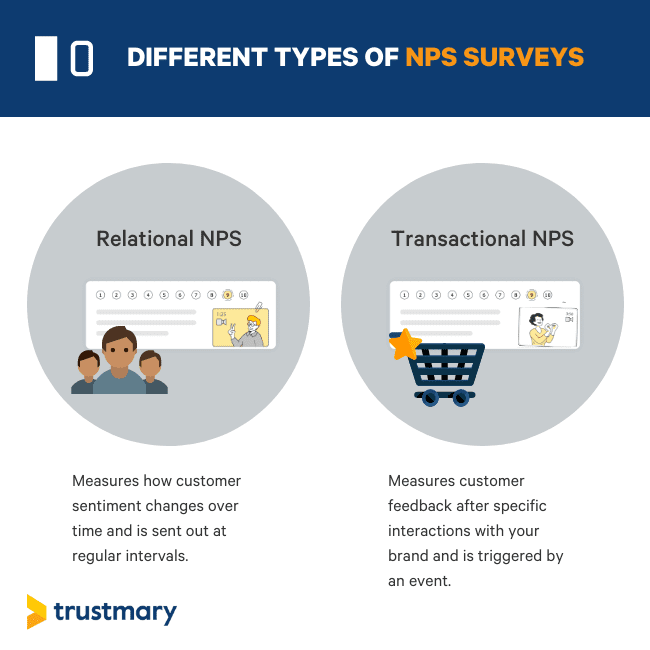
How Should I Measure NPS?
The simplicity of the Net Promoter system makes it easy to distribute to customers via your existing communication channels.
Most companies will use a combination of the following methods to capture customer feedback.
1. Email
Email NPS survey is a simple way to collect customer feedback for both relationship and transactional NPS. Usually a link to the Net Promoter Score question is provided in the email, sometimes with follow-up questions.
Survey emails can be easily automated to be triggered after key interactions with your company.
Here’s an example of how Trustmary uses email to ask transactional NPS questions:
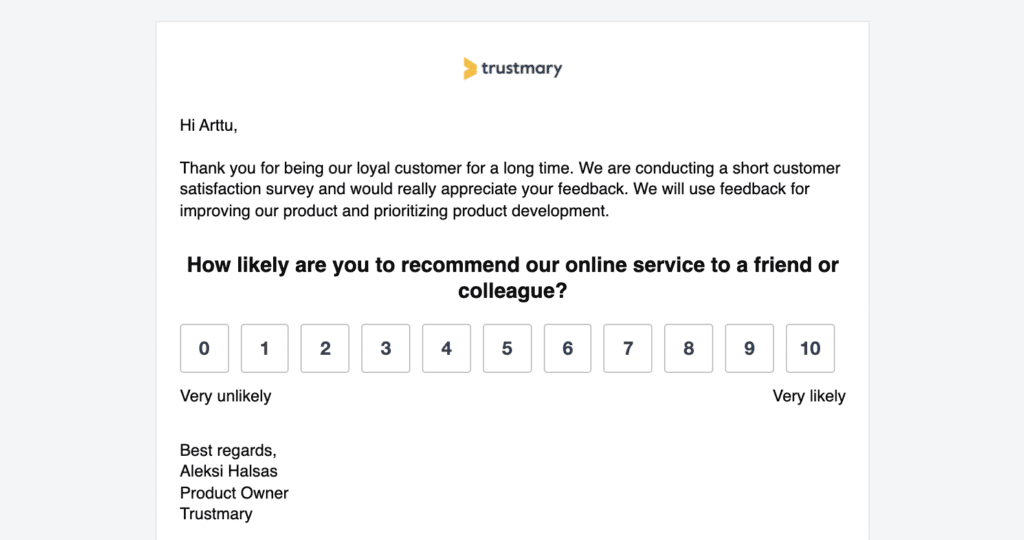
While email is a great channel for NPS systems, one of its major drawbacks is that responses rely on open rates. A low email open rate results in poor responses to the survey.
2. SMS
Mobile has transformed customer behavior. According to Gartner, SMS has a 98% open rate, compared to average email open rates of 20%.
The simplicity of NPS lends itself to the on-the-go nature of SMS or WhatsApp surveys making it a popular way to collect feedback.
Here’s how Hem & Stitch use SMS to capture customer feedback:
3. Website or in-app
Your website or app will often feature prominently in your customer journey which is why it’s a great place for a website NPS survey.
There are two ways to collect NPS responses via websites and apps: pop-ups and feedback tabs.
A pop up does exactly that - it pops up as an overlay on screen when triggered at a specific point in the customer journey. This may be after they’ve visited a page 5 times, or after they’ve checked out.
Here’s how pop ups can be used to gauge satisfaction:
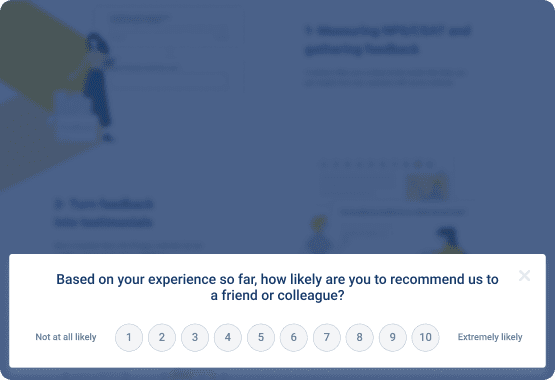
A feedback tab sits to the side of the screen and can be expanded by the user to provide feedback.
It’s more subtle than a pop up feature, but could also be more easily ignored.
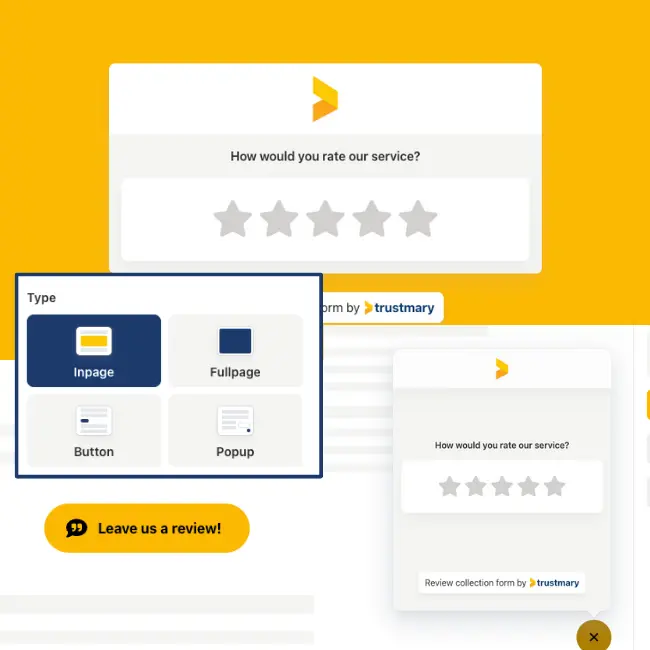
4. In person
The rise of digital applications means that nowadays most NPS data is collected online or via mobile. However, customer sentiment can also be measured in person.
For example, companies may request that customer service representatives ask the NPS question at the end of a support call.
Alternatively, a chain of shoe shops may have five-point NPS displays at tills that allow shoppers to register their level of satisfaction for that particular branch.
In-person collection, however, has been criticized for creating interviewer bias in the responses.
Tools and Software for NPS
We have spent lots of time perfecting the art of NPS and researching the best NPS software.
Here are some of the best NPS tools you can find.
- Trustmary
- Hotjar
- Promote.io
- Lumoa
- Delighted
- Survicate
- ProProfs Survey Makes
- Zonka Feedback
- Retently
- Nicereply
- SurveySparrow
- Qualtrics
You can read more about them in our articles 13 Best NPS Tools to Use and 5 Best NPS Software in 2025
Some of these tools are quite expensive and not at all attainable for smaller businesses (looking at Qualtrics, for example), while others are more suitable for any size business (like Trustmary).
CRM Enhances NPS Calculation
Many NPS tools can be integrated with Customer Relationship Management software. Doing that will enhance the accuracy of NPS surveys, as you can set much more relevant automation flows that capture feedback at the right moment.
In addition, you can store NPS data and connect it to respective customers to easily track their loyalty over time.
Once you set up an effective NPS process with a tool like Trustmary and your CRM like HubSpot or SalesForce, you don't even have to worry about it again. Everything will run smoothly and you can focus on activities that help you improve customer experience.
Analyzing My Net Promoter Score
Your Net Promoter Score can guide business decision-making and growth, but how do you analyze this crucial customer satisfaction metric?
Here are 4 tips to help you analyze your NPS:
1. Segment your data
Segmenting your data can help you understand which segment has more Promoters or Detractors.
The insights from segmenting your data can help you make better decisions based on your target group, amplify best practice,s and build more personalized experiences.
Here are some segments you can create:
- Service or product that the customer purchased: If you offer multiple services, you can notice if there are discrepancies between them.
- Location: Are all your office locations equal what comes to customer satisfaction?
- Agent who served the customer: Quick way to notice if your staff needs more training.
- Demographic data: If some demographics have a more negative sentiment than others, it may uncover bigger problems like discrimination by your staff. In less frightening scenario, you get insights into who your actual target customer is.
Of course, segmentation can become difficult when your goal is to also keep the survey short and sweet. By integrating your NPS tool with CRM, you can get your hands on much more customer data and help the segmentation process.
2. Understand your NPS Calculation
A ‘good’ NPS varies from industry to industry, and even from company to company. It can even be affected by the geographical location.
Generally speaking, keeping your score over 0 is a healthy place to be. A negative NPS is a sign of trouble.
| Below 0 | Between 0 and 30 | Higher than 30 | Over 70 |
|---|---|---|---|
| Many issues to be addressed, possibly resulting in negative word of mouth | Good but still room for improvement. | Great - the company has far more happy customers than unhappy ones. | Customers love you and your company is generating positive word-of-mouth from referrals. |
3. Benchmark your NPS
A good NPS score is all relative. The following comparisons can help you understand how well you are performing.
- Benchmarking to an agreed industry standard helps you understand what good looks like for your business.
- Compare your results against the big international brands, such as Apple, to get inspiration from the best
- It can also be beneficial to compare against companies in your geographical location, as the surrounding culture can affect how people respond to NPS surveys. For example, NPS in the Nordics can be lower than in the U.S. even if there is no actual difference in customer satisfaction.
- Comparing segments can help you understand where your Promoters and Detractors come from, and enables you to customize experiences by segment or use the data to provide actionable insights.
- Different survey channels and collection methodologies can have a big impact on your overall NPS score.
- Measuring your own customer experience regularly via an NPS software will help you see trends emerging.
Which brings us on to...
4. Measure changes in your NPS
Tracking results from NPS and searching for trends over time builds a good picture of how your company is progressing from one quarter to the next.
Systematic customer feedback also identifies if customers respond well to new products or features.
Continuous improvement to your NPS score indicates progress in customer experience and satisfaction, as well as the potential for business growth.
5. Share insights with visual reports
Analyzing NPS data becomes easier with an effective way to present NPS results.
It's also key when you want to report trends to others.
Line charts, pie charts, and bar charts are great methods of representing NPS results for different use cases.
4 Ways to Guide Decision-making with NPS
You have your NPS calculation, and you’ve analyzed the results. Let’s explore the ways in which you can maximize the impact of your NPS through good decision-making.
1. Watch what you’re measuring
NPS is a proven metric for customer experience but too often moving the needle on the NPS score becomes the goal.
As per Goodhart’s law, when a measure becomes a target, it ceases to be a good measure. You start missing the correlation between what’s going on in your business and your score and taint the whole program with bias.
“If your business is only focused on increasing Promoters, you’re missing valuable feedback from your Detractors,” said Arttu Haho, CEO of Trustmary US.
In other words, don't forget to put some effort into making your unenthusiastic customers turn into the most enthusiastic customers ever. It'll significantly help reduce negative word of mouth, too.
2. Utilize your indicator of organic growth
Bain & Company conducted a study of competitors, comparing NPS scores to organic growth: “On average, an industry’s Net Promoter leader outgrew its competitors by a factor greater than two times.”
Customer Promoters are more likely to have:
- Higher average purchase value and repurchase
- Longer customer lifetime value
- Higher referral rates
- Better engagement to offer ideas and feedback
A good NPS is an indicator of the potential for organic growth. Understand the factors that contribute to your score and work on them.
If you’re using NPS in conjunction with other metrics, such as average purchase value or upsell ratio, you’ll soon be able to see the impact of your actions.
3. Act fast on Detractors
Your Detractors are your biggest asset. No, really.
Let’s think of NPS systems like focus groups. It’s always nice to hear how well you are doing, but the feedback you really need is what isn’t going so well, and where there is room for improvement.
Understanding what your Detractors are thinking and feeling allows you to act. And time is really of the essence here.
“If you make customers unhappy in the physical world, they might each tell 6 friends,” according to Jeff Bezos, CEO of Amazon, “If you make customers unhappy on the Internet, they can each tell 6,000 friends.”
Similarly, your customer success team can really benefit from knowing who give your service a score less than 9 or 10. It'll help you fix their issues and turn them from unhappy customers to happy advocates!
Don’t forget to share the changes you’ve made based on their feedback. This is known as closing the loop.
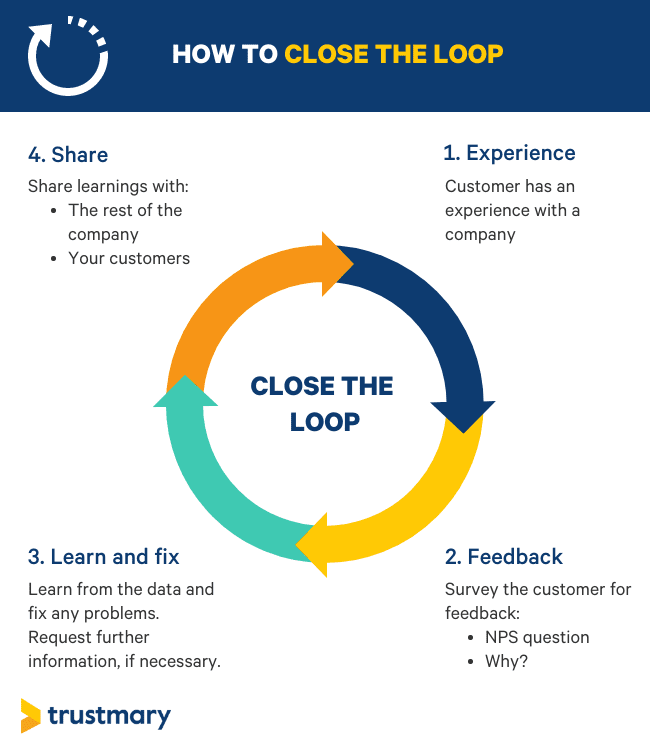
How to Close the Feedback Loop
- Customer interacts with your company
- Customer receives a survey
- Analyze the feedback data, learn and fix
- Share the insights both internally and externally
4. Follow up with your Promoters
93% of purchasers read online reviews before buying a product.
Don’t forget to approach your Promoters after you’ve conducted your NPS to share reviews about your product or service. Sharing social proof is a great way to build trust in your products and services.
Some NPS tools like Trustmary’s platform make this process easier, by allowing you to convert qualitative NPS feedback directly into testimonials.
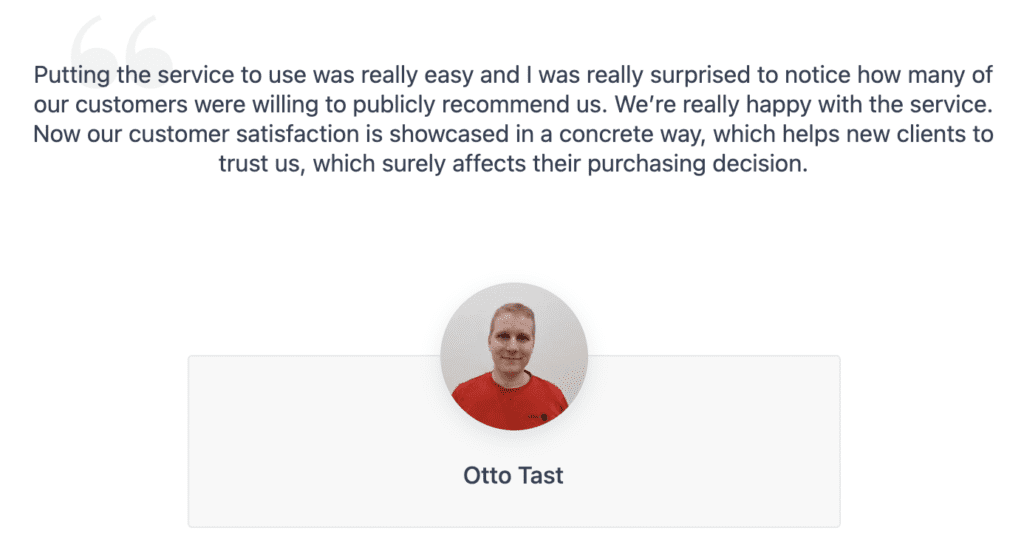
Read more about how to use social proof.
Use Cases for NPS
There are different Net Promoter Score questions that you can use in various business functions.
Let's go over a few of different use cases for Net Promoter Score.
Employee NPS
We’ve exclusively covered the traditional customer Net Promoter system in this article, but not to be forgotten is employee NPS.
Much like customer NPS, employee NPS (or eNPS) is used to measure the loyalty of employees working for an organization.
Rather than asking about likeliness of recommending products and services to a friend or colleague, an eNPS survey will ask employees:
“How likely are you to recommend our organization as a place of work?”
Responses are ranked on the same scale of 1-10, and responses are measured and analyzed in the same way as customer NPS.
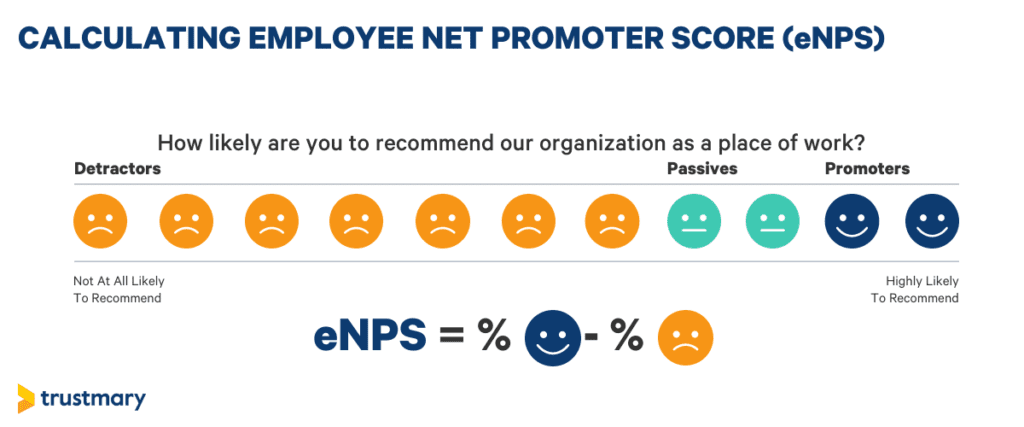
Importance of Measuring eNPS
As NPS surveys are so easy to create and their distribution can be automated, it only makes sense to measure employee NPS.
In addition to being hassle-free for the employer to set up, eNPS surveys:
- Tend to have a high response rate
- Provide a benchmark over time
- Creates accountability across business
- Increases productivity
- Helps recruit top talent, as employee experience is a resource for recruiting

NPS in Customer Service
NPS in customer service can help reveal the state of customer service, discover the need for additional staff training, or underline customer service principles.
Many companies use NPS as a way to motivate and reward employees. Each customer service agent has their own survey and collects their personal Net Promoter Score.
This method had its supporters and opponents. While a personal NPS score can help good employees get recognized and rewarded, it can also expose customer service personnel to unfair treatment by customers.
However, general NPS on customer service is beneficial for most companies. Customer service is the most important touchpoint between a company and its customers, and it's good to know that everything works well.
Sometimes it can also lead to revelations where customers are extremely satisfied with the customer service, but something else in the customer journey keeps dragging the overall score down.
NPS Customer Success
I can't stress how important NPS is for customer success.
Obviously, tracking customer loyalty is crucial for customer success, but the simple format of NPS enables customer success teams to robustly prioritize tasks and reduce manual workload.
The most important function of a Customer Success team is to retain as many customers as possible, while also making cross-sell and upsell.
NPS helps with this by providing an easy tool for identifying risks and opportunities.
When a customer is identified as a Detractor, customer success can immediately take action to prevent churn. Similarly, when a customer is identified as a Promoter, there could be a chance to expand their experienced value and sell more.
Additionally, many of these workflows can be automated based on NPS survey answers.
NPS in Marketing
NPS in marketing – what on Earth?
Well, NPS is an effective marketing tool in itself but also because it enables the collection of reviews and testimonials. And marketing loves those!
NPS helps marketing teams:
- Understand customer sentiment to craft messaging that truly resonates
- Identify brand advocates – people quite literally say they are ready to recommend you, so let them!
- Tailor nurturing campaigns for customers based on their sentiment
- Prove to potential customers that they should trust the company
Net Promoter Score in B2B
It's a common misconception that NPS is only for B2C companies. But no – B2B Net Promoter Score is also important.
In B2B, the purchase journey is long and the customer relationships often are even longer. It makes it even more crucial to stay on the pulse of your customers.
If you have 10.000 small customers, you may not feel as strongly if some of them are dissatisfied. But when you have 20 very important customers, you want to know how they are doing.
B2B NPS surveys often get a high response rate, because the customers are also very invested in the relationship.
However, things like recommendations and public reviews are more delicate in B2B. When someone publicly admits to recommending you, they put their own reputation and the whole company's reputation on the line.
Net Promoter Score Research and Criticism
In the past two decades since its introduction, NPS has secured its place as a core measurement of businesses across the world.
While business leaders advocate the use of NPS to guide the company’s growth, academics are somewhat on the fence about the value that the metric provides.
Here’s why.
- “The results are easy to manipulate, whether intentionally or unintentionally,” NPS is easy to ‘game’ by only asking happy customers for feedback, for example. Khadeeja Safdar and Inti Pacheco, Wall Street Journal (2019)
- Most negative comments about a brand come from former or never customers, and so only sampling current customers paints an inaccurate picture of negative word of mouth. Robert East et al. (2011)
- In relation to Reichheld’s initial methodology, historical growth rates can’t prove that the NPS is a leading indicator of growth. Byron Sharp (2008)
- The Net Promoter System lacks peer-reviewed research to support its proponents’ claims of strong correlation with growth. Timothy Keiningham who conducted three studies on NPS
- Only about half of those who intended to recommend specific businesses actually did so. V. Kumar, J. Andrew Petersen, and Robert P. Leone (2007)
- 52% of all people who actively discouraged others from using a brand had also actively recommended it. C Space (2019)
- NPS isn’t always the best predictor of revenue growth. Keiningham and colleagues (2007)
- NPS predicted future growth metrics, but that NPS wasn’t statistically different from other measures, concluding that there is no single best metric. Van Doorn et al. (2013)
Are NPS systems too simple?
The simplicity is one reason that NPS attracts criticism.
The Net Promoter Score system can help you identify your happy customers but alone, it provides very little information about what to do next.
Step Hyken, CX expert and author of “The Convenience Revolution”, said: “Knowing the number is one thing. Knowing the “why” behind the number and how to use it to gain a competitive advantage is another”.
Once seen as the only business growth metric needed and the surest way to measure loyalty, most companies these days use other metrics alongside NPS to get the best overview of customer experience and company performance.
NPS is relative to culture and circumstances
You can't really put all of the world's NPS scores into one pile and pick out the winners. That is because there are differences in the scoring nature between different nations and cultures.
A popular blog post excited debates about whether there should be a European version of NPS because Europeans give lower scores than e.g. Americans. The writer of this blog later admitted they were oversimplifying the issue, and there are differences across all countries, within Europe and outside of it.
Additionally, not only culture determines how people respond. It's also the context, where and when they were asked about it.
All of these variables make NPS easy to game and not produce an accurate analysis of customer loyalty and satisfaction.
Thus, the best opponent to benchmark against is your own company in the past!
Alternatives to NPS
The traditional NPS method isn’t the only customer experience metric. We explore some alternatives to NPS that you can try.
NPS variations
You can still use the same NPS question, but give different ways to respond. Try adjusting the scale to 0-5, or changing the wording to better suit your business purposes.
A narrower scale can make it easier for a customer to choose the right rating, and not make tiny differences so definitive. A difference between 8 and 9 can be insignificant for the respondent, but very significant for your NPS.
The difference between a 4 and a 5 is already much more significant.
Customer Satisfaction (CSAT)
CSAT asks: “How satisfied were you with our service/product?” Customers then rank their level of satisfaction, usually on a scale from 1-5. The Net Promoter score focuses on measuring overall customer loyalty.
Key differences between CSAT and NPS
- Measure different aspects of customer experience
- Frequency of use
- Event vs. customer journey
- Versatility

Customer Effort Score (CES) vs NPS
Customer effort score ranks ease of use, a key factor to customer satisfaction. CES asks “How much effort did it take to deal with us?” and has respondents rank that level of effort on a 1-5 scale.
CES is great for measuring, for example, the level of service of your support team. NPS will reflect how existing customers feel about your whole brand, not just one interaction.
Churn rates
Churn rate measures the percentage of customers that do not renew their business with a particular company. Retention (aka keeping your customers) is typically cheaper than getting new customers. That's why all companies need to track them.
However, the Net Promoter system is a great metric to consider as a tool to predict and prevent churn.
Grow NPS with Regular Surveys
NPS is a useful metric for businesses of all shapes and sizes, allowing you to measure your customer experience, gauge loyalty, return insights faster and fuel growth.
However, the Net Promoter Score scale by itself is just a vanity number that companies should be careful doesn’t turn into a goal itself.
NPS is best used as a diagnostic tool in conjunction with an open-ended question to find out why customers feel the way they do, and other metrics to get a complete picture of customer experience and opportunities for growth.
Other ways to measure the happiness of your clientele include CSAT, CES and churn rates, but whichever method you use, ensure that you are making the most out of the feedback.
Give your marketing a boost with social proof from your Promoters, or create an action plan to address pain points from your Detractors.
Or as Michael LeBouef, business author, puts it: “A satisfied customer is the best business strategy of all.”
FAQ about Net Promoter Score
Is Net Promoter Score a worthwhile metric to use?
NPS is a great metric for measuring customer loyalty because:
- It’s simple to measure.
- It produces a number you can use to track your customer experience.
- It can be used alongside other measures to paint a complete picture of how your business is performing.
How is NPS calculated?
The formula for NPS is simple to calculate:
% Promoters minus % Detractors
The result is a number between -100 and +100.
What is a good Net Promoter Score?
A good NPS is relative.
It depends on your industry, competitors, and region, and most importantly, how your business has previously performed.
Generally speaking, an NPS higher than 0 is a good starting point. You should measure yourself against NPS industry averages
What is a bad Net Promoter Score?
A bad NPS is considered to be anything lower than 0. This indicates that you have more unhappy customers than happy ones.
What is a NPS question?
NPS is based on a single question.
“How likely are you to recommend us to a friend or colleague?”
This question can be reworded slightly depending on the audience, e.g. employees, or whether you’re measuring relationship NPS (sentiment towards the brand as a whole) or transactional NPS data (sentiment towards a particular product or service).
The NPS question should be followed up with additional questions to provide qualitative insights into why your buyers feel a certain way.
What questions should I ask alongside NPS?
NPS rating questions tell you what your clientele thinks, whereas an open-ended question helps you find out why:
An example of a general follow up question is: tell us in your own words why you gave this score?
Some specific follow up questions are:
- Tell us what was missing in your experience with us?
- What did you love about your experience with us?
- How can we improve your experience?
How should an NPS survey be structured?
An effective NPS survey will be structured in two-parts: a rating question and an open-ended question.
- The rating question measures what your buyers feel, rated on a scale of 0 - 10.
- The open-ended question acts as a follow up and measures why a specific score was given.
Thanking your respondents for their time is a good way to finish your NPS survey, letting them know that you appreciate their feedback.
What should I do about my Detractors?
NPS is effective at revealing what your clients don’t like about your company. Once you have your results, you should:
- Use the qualitative data to find out why your Detractors are unhappy.
- Explore other metrics that help measure customer experience. For example, if your detractors don’t like the UX of your new website, check if your bounce rates support this.
- Act quickly to implement changes and let them know that you have done so.
- Measure again to see if your actions have an impact.
What should I do with my Promoters?
Your Promoters are already enthusiastic about your business, as they give you a 9 or 10. Here’s how you can make the most of them:
- Analyze open-ended responses to find out what your Promoters love about you.
- Roll out any best practice to other segments.
- Follow up with your Promoters to see if they’d be happy to provide a testimonial, or use a platform like Trustmary to turn qualitative responses into reviews, fast.
- Identify growth opportunities you can test with your Promoters - after all, they’re more likely to buy more from your business, so trying out an upsell campaign may contribute to revenue growth.
What kind of conclusions can I make from my NPS?
The NPS score alone can give you a general picture of sentiment towards your business, product or service.
Qualitative follow-up questions allow you to start exploring what specifically is working, and what isn’t.
Combined alongside other metrics can help you pinpoint exactly where pain points lie and how these can be improved.
Repeating the survey gives you the opportunity to follow your progress and monitor how changes are received.
How often should you ask for NPS?
NPS should be measured regularly so that you are able to track trends.
Generally speaking, measuring once a quarter to once a year will help you build a good picture of your progress. Whichever time frame you go with, remember to be consistent.
Can I modify the NPS question?
NPS tends to have a standard format, however, the wording can be customized slightly according to the audience and the goals of your program.
How accurate is NPS?
The accuracy of your NPS can vary according to your collection methodology. For example, in person collection may result in a positive bias, or incentivising NPS could cause false positive results.
While it may not be possible to eliminate bias altogether, taking a consistent approach to how you collect data each time you survey your customers will help create a reliable picture of loyalty and how it changes over time.
What is eNPS?
eNPS refers to employee Net Promoter Score. It measures how loyal your employees are. As the regular NPS score, you should measure eNPS regularly, not just once a year.
Should I use NPS software?
We recommend automating as much of your survey processes as possible and a great way to do that is to use NPS software. That way, you can focus on improving your NPS results within different segments rather than sending surveys manually. NPS software can be used to automate the whole process to key touch points in your customer journey.
